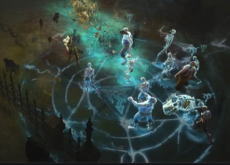In the presence of allies, the priest features a few other options: After casting a spiritual weapon, a priest may prefer to cast a guiding bolt rather than sacred flame at an enemy whom one among his or her allies is engaging: successful gives the priest 4d6 radiant damage and his or her ally advantage on a subsequent attack roll against that enemy. Also, just like the acolyte, a priest can cast cure wounds on an ally who’s taken a moderate wound or worse, or sanctuary on an ally who needs an emergency bailout. (Remember that leveled spells cast as bonus actions, like a sanctuary and spiritual weapon, maybe paired within the same turn only with cantrips, like a sacred flame—not with other leveled spells that are cast as actions, like guiding bolt.)
- Make a melee spell attack against a creature you’ll reach. On a hit, the target takes 3d10 necrotic damage.
- At Higher Levels: once you cast this spell using a spell slot of 2nd Level or higher, the damage increases by 1d10 for every slot level above 1st.
When laying your hand upon a creature, you channel negative energy that deals 1d8 points of injury +1 point per caster level (maximum +5). Since undead are powered by negative energy, this spell cures such a creature of a like amount of injury, instead of harming it.
Inflict Wounds 5e

- Casting Time: 1 action
- Range: Touch
- Components: V S
- Duration: Instantaneous
- Classes: Cleric
Negative energy spreads call at all directions from the purpose of origin, dealing 1d8 points of injury + 1 point per caster level (maximum +25) to nearby living enemies.
Like other inflict spells, mass inflict light wounds cures undead in its area instead of damaging them. A cleric capable of spontaneously casting inflict spells also can spontaneously cast mass to inflict spells.
You drain the life from a neighborhood in range. Form to 6 creatures during a 30-foot-radius sphere centered thereon point. On a failed Wisdom saving throw, each target takes 6d8 necrotic damage. This spell has no effect on constructs and undead.
Check also: D&D 5e Races
Finally, druids are, interestingly, scrappier than your average clergyperson, with slightly above-average Dexterity and Constitution and therefore the delightful shillelagh cantrip, which boosts their attack modifiers with staves from +2 to +4 and their damage from 1d6 to 1d8 + 2 (the MM says just 1d8, but this is often a documented error) and costs only a bonus action. the large gun in their arcane arsenal, though, is entangled, an area-effect spell that has the potential to restrain enemies, granting them disadvantage on attacks and advantage on attacks against them—plus making them sitting ducks for damaging spells that need Dex saves. (Unfortunately, druids don’t pack any of these .)
Druids keep to themselves, so any encounter with one is going to be on his or her house turf, presumably, and their goal within the event of conflict are going to be to form the PCs getaway (if they’re weaker) or to urge faraway from the PCs (if they’re stronger). We’re looking primarily at two tactical combinations here. One is entangled (action) plus produce flame (action): first, restrain the PCs; second, while they’re restrained, lob flames at them with advantage for 1d8 fire damage a pop. The opposite is shillelagh (bonus action) plus a melee weapon attack (action), with thunderwave as a backup for when the druid is surrounded by three or more melee opponents and wishes to require the warmth off. Either could also be effective for standing one’s ground, counting on circumstances, terrain, and therefore the opposition.

Virat Rana is a Blogger from the city of Joy, Kolkata. He is the founder of this blog and covers a wide range of topics from Gadgets to Software to the Latest Offers. You can get in touch with him via [email protected]
